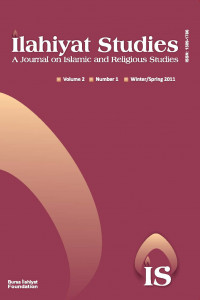A Quantitative and Stylo-Statistical Approach to the Phono-Semantic Structure of Two Companion-Prayers of the Qurʾān: al-Falaq and al-Nās
Abstract
companion-prayers in the Qurʾān. Although both prayers exhibit a
marked symmetry on both lexical and phonological levels, this symmetry
has not been extensively studied by scholars due to the highly
familiar nature of these two short prayers. Immediately noticeable on
the phonological scale is the highly cacophonous and staccato
rhythms of al-Falaq, which appear to be produced by a profusion of
fricatives (/f/, /kh/) and plosives (/q/, /b/, /d/), combined with a
scarcity of nasals and glides. In contrast, al-Nās has a much smoother
sound patterning as a result of the profusion of nasals and sibilants.
This striking numerical difference in the phonological configuration
of these two companion-prayers leads us to suspect the presence of
phonosymbolism or a correlation between phonological patterning
and subject matter. In other words, this variation can be accounted for
by shifts in subject matter from the dynamic process of “splitting” in
al-Falaq to the movements of the Hisser (Satan) in al-Nās. Subjecting
the phonological data in both texts to simple statistical checks will allow
us to be sure that these observed patterns are indeed statistically
significant and not attributed simply to chance variability. The perspective
that I am adopting here is stylo-statistical, where the main
purpose is to devise a measure that is not only statistically satisfactory
but stylistically interesting as well.
Keywords
Arabic phonosymbolism phonological symmetry stylostatistics Arabic Qurʾān iconicity functions of fricatives and plosives
References
- al-ʿAbd, Muḥammad (1984), al-Mufāraqat al-Qurʾāniyya (Cairo: Dār al-Fikr al-ʿArabī).
- Abū Mūsā, Muḥammad (1987), Dalālāt al-tarākīb (Cairo: Maktabat Wahba).
- al-Andalusī, Abū Ḥayyān Muḥammad ibn Yūsuf al-Gharnāṭī (1983), Tafsīr al-baḥr al-muḥīṭ, 8 vols., (Beirut: Dār al-Fikr).
- Bū ʻʿUmāma, Muḥammad (2002), "al-Ṣawt wa-l-dalāla: Dirāsa fī dawʾʼ al-turāth wa-ʿilm al-lugha al-ḥadīth," Majallat al-turāth al-ʿArabī 85, 11-26.
- Crystal, David (1997), The Cambridge Encyclopedia of Language (2nd ed., Cambridge: Cambridge University Press).
- Fatani, Afnan H. (2006), "Translation and the Qurʾan," in Oliver Leaman (ed.), The Qurʾan: An Encyclopedia (London & New York: Routledge), 657-669.
- Fatani, Afnan H. (2005), "The iconic-cognitive role of fricatives and plosives: A phono-semantic analysis of a classical Arabic prayer Al-falaq," in Constantino Maeder, Olga Fischer and William J. Herlofsky (eds.), Outside-In - Inside-Out [Iconicity in Language and Literature 4] (Amsterdam: John Benjamins Publishing Company), 173-193.
- Fatani, Afnan H. (2002a), "A Diachronic Semantic Error Analysis (DSEA) of Arabic Non-core Lexicon: Chapter 114 of the Quran/An-naas ('The People')," Language Forum 28/1, 51-70.
- Fatani, Afnan H. (2002b), "The Lexical Transfer of Arabic Non-core Lexicon: Sura 113 of the Qurʾan - al-Falaq (The Splitting)," Journal of Qurʾanic Studies 4/2, 61-81.
- Fischer, Olga and Nänny, Max (2001), "Introduction: Iconicity and Nature," European Journal of English Studies 5/1, 3-16. https://doi.org/10.1076/ejes.5.1.3.4782
- Ḥassān, Tammām (1993), Al-bayān fī rawāʾiʿ al-Qurʾān (Cairo: ʿĀlam al-Kutub).
- Ibn Jinnī, Abū l-Fatḥ ʻʿUthmān al-Mawṣilī (1974), al-Khaṣāʾiṣ, 3 vols., (ed. Muḥammad ʿAlī al-Najjār; Beirut: Dār al-Hudā).
- Kenny, Anthony (1982), The Computation of Style: An Introduction to Statistics for Students of Literature and Humanities (Oxford: Per-gamon Press).
- Lyons, John (1977), Semantics, 2 vols., (Cambridge: Cambridge University Press).
- al-Rāfiʿī, Muṣṭafā Ṣādiq (1990), Iʿjāz al-Qurʾān wa-l-balāgha al-nabawiyya (Beirut: Dār al-Kitāb al-ʿArabī).
- al-Ṣaghīr, Muḥammad Ḥasan ʿAlī (2002), al-Ṣawt al-lughawī fī l-Qurʾān (Beirut: Dār al-Muʾarrikh al-ʿArabī).
- al-Zamakhsharī, Abū l-Qāsim Jār Allāh Maḥmūd ibn ʿUmar (1947), al-Kashshāf ʿan ḥaqāʿiq ghawāmiḍ al-tanzīl wa-ʿuyūn al-aqāwīl fī wujūh al-taʾwīl, 4 vols., (ed. ʿAbd al-Razzāq al-Mahdī; Beirut: Dār Iḥyāʾʼal-Turāth al-ʿArabī).
Abstract
References
- al-ʿAbd, Muḥammad (1984), al-Mufāraqat al-Qurʾāniyya (Cairo: Dār al-Fikr al-ʿArabī).
- Abū Mūsā, Muḥammad (1987), Dalālāt al-tarākīb (Cairo: Maktabat Wahba).
- al-Andalusī, Abū Ḥayyān Muḥammad ibn Yūsuf al-Gharnāṭī (1983), Tafsīr al-baḥr al-muḥīṭ, 8 vols., (Beirut: Dār al-Fikr).
- Bū ʻʿUmāma, Muḥammad (2002), "al-Ṣawt wa-l-dalāla: Dirāsa fī dawʾʼ al-turāth wa-ʿilm al-lugha al-ḥadīth," Majallat al-turāth al-ʿArabī 85, 11-26.
- Crystal, David (1997), The Cambridge Encyclopedia of Language (2nd ed., Cambridge: Cambridge University Press).
- Fatani, Afnan H. (2006), "Translation and the Qurʾan," in Oliver Leaman (ed.), The Qurʾan: An Encyclopedia (London & New York: Routledge), 657-669.
- Fatani, Afnan H. (2005), "The iconic-cognitive role of fricatives and plosives: A phono-semantic analysis of a classical Arabic prayer Al-falaq," in Constantino Maeder, Olga Fischer and William J. Herlofsky (eds.), Outside-In - Inside-Out [Iconicity in Language and Literature 4] (Amsterdam: John Benjamins Publishing Company), 173-193.
- Fatani, Afnan H. (2002a), "A Diachronic Semantic Error Analysis (DSEA) of Arabic Non-core Lexicon: Chapter 114 of the Quran/An-naas ('The People')," Language Forum 28/1, 51-70.
- Fatani, Afnan H. (2002b), "The Lexical Transfer of Arabic Non-core Lexicon: Sura 113 of the Qurʾan - al-Falaq (The Splitting)," Journal of Qurʾanic Studies 4/2, 61-81.
- Fischer, Olga and Nänny, Max (2001), "Introduction: Iconicity and Nature," European Journal of English Studies 5/1, 3-16. https://doi.org/10.1076/ejes.5.1.3.4782
- Ḥassān, Tammām (1993), Al-bayān fī rawāʾiʿ al-Qurʾān (Cairo: ʿĀlam al-Kutub).
- Ibn Jinnī, Abū l-Fatḥ ʻʿUthmān al-Mawṣilī (1974), al-Khaṣāʾiṣ, 3 vols., (ed. Muḥammad ʿAlī al-Najjār; Beirut: Dār al-Hudā).
- Kenny, Anthony (1982), The Computation of Style: An Introduction to Statistics for Students of Literature and Humanities (Oxford: Per-gamon Press).
- Lyons, John (1977), Semantics, 2 vols., (Cambridge: Cambridge University Press).
- al-Rāfiʿī, Muṣṭafā Ṣādiq (1990), Iʿjāz al-Qurʾān wa-l-balāgha al-nabawiyya (Beirut: Dār al-Kitāb al-ʿArabī).
- al-Ṣaghīr, Muḥammad Ḥasan ʿAlī (2002), al-Ṣawt al-lughawī fī l-Qurʾān (Beirut: Dār al-Muʾarrikh al-ʿArabī).
- al-Zamakhsharī, Abū l-Qāsim Jār Allāh Maḥmūd ibn ʿUmar (1947), al-Kashshāf ʿan ḥaqāʿiq ghawāmiḍ al-tanzīl wa-ʿuyūn al-aqāwīl fī wujūh al-taʾwīl, 4 vols., (ed. ʿAbd al-Razzāq al-Mahdī; Beirut: Dār Iḥyāʾʼal-Turāth al-ʿArabī).
Details
| Primary Language | English |
|---|---|
| Subjects | Religious Studies |
| Journal Section | Research Articles |
| Authors | |
| Publication Date | June 1, 2011 |
| Submission Date | September 23, 2010 |
| Published in Issue | Year 2011 Volume: 2 Issue: 1 |
Web of Science Rank by Journal Citation Indicator (JCI)



